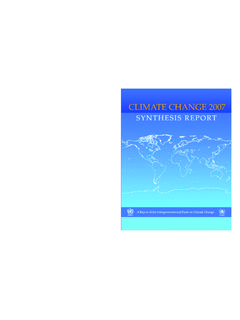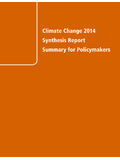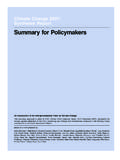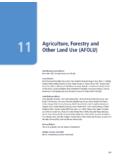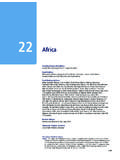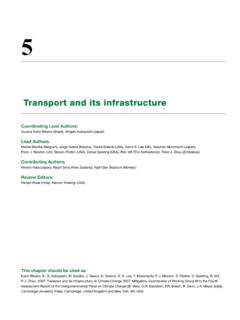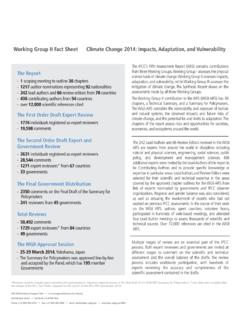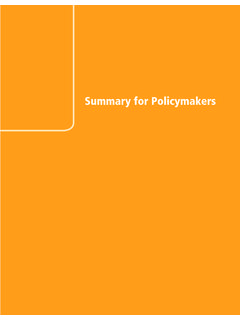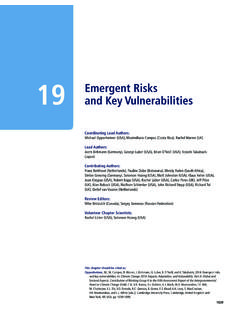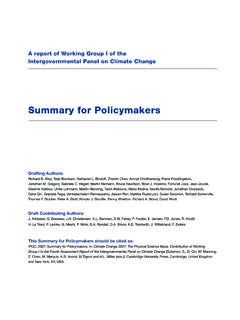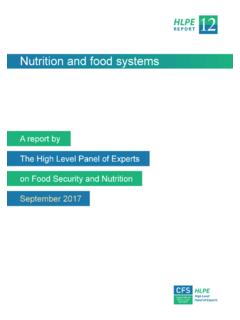Transcription of 7 — Food Security and Food Production Systems
1 food Security and 7 food Production Systems Coordinating Lead Authors: John R. Porter (Denmark/UK), Liyong Xie (China). Lead Authors: Andrew J. Challinor (UK), Kevern Cochrane (South Africa), S. Mark Howden (Australia), Muhammad Mohsin Iqbal (Pakistan), David B. Lobell (USA), Maria Isabel Travasso (Argentina). Contributing Authors: Netra Chhetri (USA/Nepal), Karen Garrett (USA), John Ingram (UK), Leslie Lipper (Italy), Nancy McCarthy (USA), Justin McGrath (USA), Daniel Smith (UK), Philip Thornton (UK), James Watson (UK), Lewis Ziska (USA). Review Editors: Pramod Aggarwal (India), Kaija Hakala (Finland). Volunteer Chapter Scientist: Joanne Jordan (UK).
2 This chapter should be cited as: Porter, , L. Xie, Challinor, K. Cochrane, Howden, Iqbal, Lobell, and Travasso, 2014: food Security and food Production Systems . In: Climate Change 2014: Impacts, Adaptation, and Vulnerability. Part A: Global and Sectoral Aspects. Contribution of Working Group II to the Fifth Assessment Report of the Intergovernmental Panel on Climate Change [Field, , Barros, Dokken, Mach, Mastrandrea, Bilir, M. Chatterjee, Ebi, Estrada, Genova, B. Girma, Kissel, Levy, S. MacCracken, Mastrandrea, and White (eds.)]. Cambridge University Press, Cambridge, United Kingdom and New York, NY, USA, pp. 485-533. 485. Table of Contents Executive Summary.
3 488. Introduction and Context .. 490. food Systems .. 490. The Current State of food Security .. 490. Summary from AR4 .. 491. Observed Impacts, with Detection and Attribution .. 491. food Production Systems .. 491. Crop Production .. 491. Fisheries Production .. 493. Livestock Production .. 494. food Security and food Prices .. 494. Assessing Impacts, Vulnerabilities, and Risks Methods and Associated Uncertainties .. 494. Assessing Impacts .. 494. Treatment of Adaptation in Impacts Studies .. 497. Sensitivity of food Production to Weather and Climate .. 497. Cereals and Oilseeds .. 497. Other Crops .. 499. Pests, Weeds, Diseases.
4 500. Fisheries and Aquaculture .. 500. food and Fodder Quality and Human Health .. 501. Pastures and Livestock .. 502. Sensitivity of food Security to Weather and Climate .. 502. Non- Production food Security Elements .. 502. Accessibility, Utilization, and Stability .. 502. Sensitivity of Land Use to Weather and Climate .. 504. Projected Integrated Climate Change Impacts .. 505. Projected Impacts on Cropping Systems .. 505. Projected Impacts on Fisheries and Aquaculture .. 507. Projected Impacts on Livestock .. 508. Box 7-1. Projected Impacts for Crops and Livestock in Global Regions and Sub-Regions under Future Scenarios .. 509.
5 Projected Impacts on food Prices and food Security .. 512. 7. 486. food Security and food Production Systems Chapter 7. Adaptation and Managing Risks in Agriculture and Other food system Activities .. 513. Adaptation Needs and Gaps Based on Assessed Impacts and Vulnerabilities .. 513. Methods of Treating Impacts in Adaptation Studies Incremental to Transformational .. 513. Practical Regional Experiences of Adaptation, Including Lessons Learned .. 518. Observed and Expected Barriers and Limits to Adaptation .. 518. Facilitating Adaptation and Avoiding Maladaptation .. 518. food system Case Studies of Adaptation Examples of Successful and Unsuccessful Adaptation.
6 518. Key Findings from Adaptations Con dence Limits, Agreement, and Level of Evidence .. 519. Research and Data Gaps food Security as a Cross-Sectoral Activity .. 520. References .. 520. Frequently Asked Questions : What factors determine food Security and does low food Production necessarily lead to food insecurity? .. 494. : How could climate change interact with change in sh stocks and ocean acidi cation? .. 507. : How could adaptation actions enhance food Security and nutrition? .. 514. 7. 487. Chapter 7 food Security and food Production Systems Executive Summary The effects of climate change on crop and terrestrial food Production are evident in several regions of the world (high confidence).
7 Negative impacts of climate trends have been more common than positive ones. {Figures 7-2, 7-7} Positive trends are evident in some high- latitude regions (high confidence). Since AR4, there have been several periods of rapid food and cereal price increases following climate extremes in key producing regions, indicating a sensitivity of current markets to climate extremes, among other factors. {Figure 7-3, Table 18-3} Several of these climate extremes were made more likely as the result of anthropogenic emissions (medium confidence). {Table 18-3}. Climate trends are affecting the abundance and distribution of harvested aquatic species, both freshwater and marine, and aquaculture Production Systems in different parts of the world.
8 { , , } These are expected to continue with negative impacts on nutrition and food Security for especially vulnerable people, particularly in some tropical developing countries { }, but with benefits in other regions that become more favorable for aquatic food Production (medium confidence). { }. Studies have documented a large negative sensitivity of crop yields to extreme daytime temperatures around 30 C. {WGII AR4. Chapter 5, } These sensitivities have been identified for several crops and regions and exist throughout the growing season (high confidence). Several studies report that temperature trends are important for determining both past and future impacts of climate change on crop yields at sub-continental to global scales (medium confidence).
9 { , Box 7-1} At scales of individual countries or smaller, precipitation projections remain important but uncertain factors for assessing future impacts (high confidence). { , Box 7-1}. Evidence since AR4 confirms the stimulatory effects of carbon dioxide (CO2) in most cases and the damaging effects of elevated tropospheric ozone (O3) on crop yields (high confidence). Experimental and modeling evidence indicates that interactions between CO2. and O3, mean temperature and extremes, water, and nitrogen are nonlinear and difficult to predict (medium confidence). { , Figure 7-2}. Changes in climate and CO2 concentration will enhance the distribution and increase the competitiveness of agronomically important and invasive weeds (medium confidence).
10 Rising CO2 may reduce the effectiveness of some herbicides (low confidence). The effects of climate change on disease pressure on food crops are uncertain, with evidence pointing to changed geographical ranges of pests and diseases but less certain changes in disease intensity (low confidence). { }. All aspects of food Security are potentially affected by climate change, including food access, utilization, and price stability (high confidence). { , Table 7-1} There remains limited quantitative understanding of how non- Production elements of food Security will be affected, and of the adaptation possibilities in these domains. Nutritional quality of food and fodder, including protein and micronutrients, is negatively affected by elevated CO2, but these effects may be counteracted by effects of other aspects of climate change (medium confidence).
